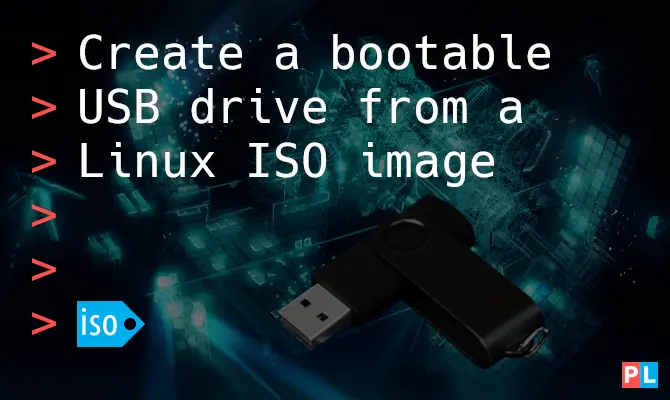
- WRITE ISO TO USB LINUX HOW TO
- WRITE ISO TO USB LINUX .EXE
- WRITE ISO TO USB LINUX INSTALL
- WRITE ISO TO USB LINUX ISO
- WRITE ISO TO USB LINUX DOWNLOAD
It works with older computers with 256MB of Dram and a 700Mhz processor. I have used puppy linux since around 2008, It is small It is fast.
WRITE ISO TO USB LINUX ISO
ISO files Tahrpup 6.0.2 puppylinux or Slacko 5.7 puppylinux a puppylinux that uses slackware 14.0 application repositories.
WRITE ISO TO USB LINUX DOWNLOAD
Puppy Linux download site Here is puppylinux website to download. 4.) Change BIOS to boot from USB Flash disk drive before Hard Disk drive or hit F12 key during boot to select “”boot device”” 5.) Computers BIOS wont boot from a USB flash drive, check out Plop Boot manager or PlopKexec below.īest Wishes in your exploration of Linux. ISO file to a USB Flash Disk Drive that you have inserted into your Windows computer.
WRITE ISO TO USB LINUX .EXE
EXE file and execute from the folder you downloaded it to. ISO file or another distribution of linux. ISO file to a USB Flash Disk Drive.ġ.) Download either puppylinux. exe file/program to run in Windows to burn a. Make sure to modify the computer BIOS to boot from a USB flash drive before the CD or before the Hard Disk drive.
WRITE ISO TO USB LINUX INSTALL
“Here is a short Howto with Links to use a Windows computer to install Linux to a USB flash drive and play with linux without changing your windows machine.

I was really excited to get my hands on an HP Chromebook 14, so I could tool around with it but now I may give the whole thing a pass. I wanted to dual boot as here because I have never used Linux in any form before, and when I came across bodhi it sounded great because of its small footprint, and reports that it lagged less the Ubuntu (also I like chromeOS.) I am a bit discouraged at the moment with the whole process, especially having to jump from page to page to find all the instructions perhaps if they were written out in the wiki for complete n00bs like myself. iso image within chromeOS from the Downloads folder to the flash drive. “(This may have already been posted before I created an account, sorry for the re-post if so.) Do I need to be in dev mode to run these commands in crosh? Because I am re-downloading bodhi-3.0.0-chromebook.iso and while I finally got into SeaBIOS and even though the BIOS could see my flash drive it was not reading it so I restored to the beginning (out of the box.) I had copied the.
:max_bytes(150000):strip_icc()/002-how-to-burn-iso-to-usb-in-linux-4588767-3dc9f70bd83a498c9a16d3ed2b4dd313.jpg)
Have any questions feel free to drop them in a comment below. So grab yourself something to drink while it is working and just let it do its thing.

Lastly, writing images takes some time and the dd command does not provide feedback while it is running. Meaning it is simply /dev/sdc not /dev/sdc1. Second is that the path to the USB drive we want to write to does not contain a partition letter. First is that this command needs to be run as root, so we have prefixed it with the sudo command. iso of=/dev/sdcĪ couple of things to note about this command. Please note that running this command will erase all data from your USB drive. Next I will run the command that writes the ISO image to the USB device. In this case I have it saved in my Downloads folder so I will run the command: cd ~/Downloads Next I need to change directories to where my ISO image is saved to. The /dev/sdc drive that has now appeared when I attached the USB drive is the device I want to write my image to.

dev/sda /dev/sda2 /dev/sda4 /dev/sdb /dev/sdc /dev/sda1 /dev/sda3 /dev/sda5 /dev/sdb1 /dev/sdc1 Next I plug in the USB drive I want to write the image to and run the above command again. I do not want to write the Linux image over one of these existing drives. These are the drives that are already attached to my computer. dev/sda /dev/sda2 /dev/sda4 /dev/sdb /dev/sda1 /dev/sda3 /dev/sda5 /dev/sdb1 You will see an output that looks something like (but not exactly) like this: Before you attach the USB drive to your computer run open a terminal and run the command: ls /dev/sd* To start we need to determine the location of the drive we want to write to. For this example I am going to use the latest Bodhi 3.0.0 32bit ISO image (which you can find here) and I am going to assume the ISO image is saved in my user’s Downloads folder.
WRITE ISO TO USB LINUX HOW TO
This is going to be a short tutorial on how to create a bootable USB drive for your favorite Linux distribution.įirst things first you are going to need to have a copy of the ISO image you want to make a bootable media of and a flash drive that is as large (or larger) than the ISO image. What many newer Linux users may not be aware of is that if they are creating their bootable Linux media from an existing Linux system (or another Unix based OS such as OSX) their computer has a built in command for creating a bootable USB device. There are a lot of different tools such as Unetbootin and Image Writer that exist for creating bootable Linux media on a USB device.


 0 kommentar(er)
0 kommentar(er)
